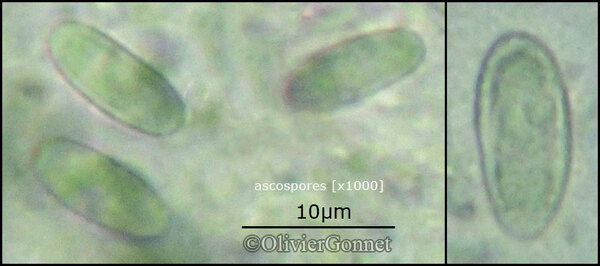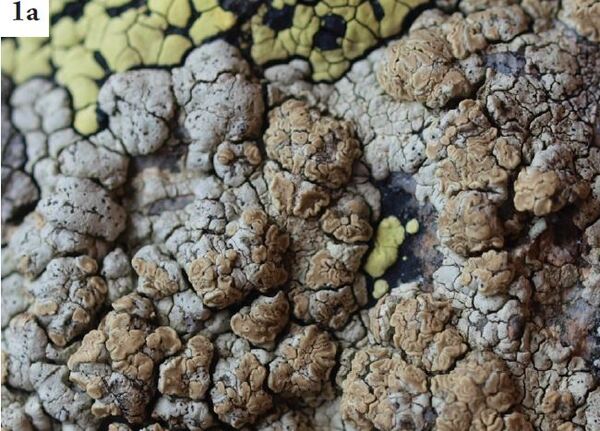Lecanora alpigena (Ach.) Cl. Roux
in Roux & al., Bull. Soc. linn. Provence, num. spéc. 14: 108, 2011. Basionym: Lecanora varia var. alpigena Ach. - Lichenogr. Univ.: 379, 1810.
Synonyms: Lecanora polytropa var. alpigena (Ach.) Rabenh.
Distribution: N - Frl, Ven, TAA (Nascimbene & al. 2022), Lomb, Piem (Isocrono & al. 2003, 2004, 2006, Isocrono & Piervittori 2008), VA (Piervittori & al. 1998, 2004, Piervittori & Isocrono 1999), Emil (Fariselli & al. 2020), Lig.
Description: Thallus crustose, episubstratic, rimose-areolate to areolate, usually poorly developed and visible only around the apothecia, yellowish green to pale grey-green, without a distinct prothallus, the areoles 0.2-3 mm wide, Cortex 20-30 μm thick, with a thin epinecral layer of dead cells and crystals, and a thicker paraplectenchymatous layer which is divided into 2 sub-layers: an upper, pale brownish yellow layer rich in small yellowish crystals and somehow larger colourless crystals partially soluble in N and totally soluble in K, and a lower, colourless layer devoid of, or poor in crystals; algal layer continuous; medulla of mostly anticlinally arranged hyphae. Apothecia lecanorine, adnate to sessile and constricted at base, round to irregular, 0.4-1.5 mm across, with a brownish to yellow-brown, flat to more or less convex, often umbonate disc, and a thin, flexuose-crenulate thalline margin. Thalline exciple up to 100 µm thick, corticate, rich in algae, the outer layer of cortex with granules and crystals; epithecium colourless to pale reddish brown, with granular crystals dissolving in K; hymenium colourless to pale yellow; paraphyses sparingly branched and anastomosing, slightly thickened at apex; hypothecium pale yellowish brown. Asci 8-spored, clavate, very thin-walled, with a K/I+ blue, tall tholus penetrated by a faintly amyloid apical cushion, the wall K/I-, surrounded by a blue outer layer, Lecanora-type. Ascospores 1-celled, hyaline, broadly ellipsoid, 10-14.5 x 5-6.5 μm, thin-walled. Pycnidia immersed, with a pale yellow-brown ostiole, Conidia acicular to arcuate. Photobiont chlorococcoid. Spot tests: thallus K- or K+ pale yellow, C-, KC+ yellow, P-. Chemistry: usnic acid, zeorin.Note: on siliceous or slightly calciferous rocks in upland areas, with optimum above treeline. The description follows the concept of Roux & al. (2022).
Growth form: Crustose
Substrata: rocks
Photobiont: green algae other than Trentepohlia
Reproductive strategy: mainly sexual
Commonnes-rarity: (info)
Alpine belt: common
Subalpine belt: rather rare
Oromediterranean belt: absent
Montane belt: absent
Submediterranean belt: absent
Padanian area: absent
Humid submediterranean belt: absent
Humid mediterranean belt: absent
Dry mediterranean belt: absent
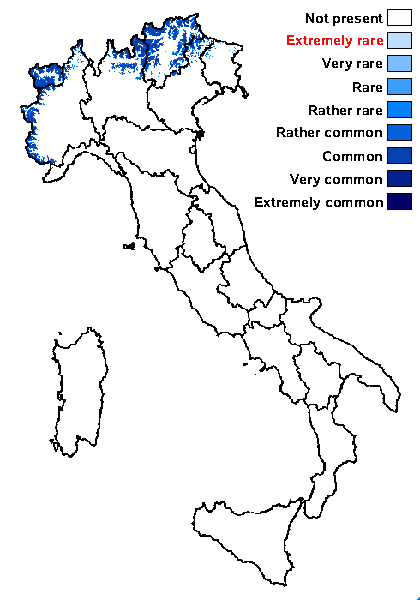
Predictive model
Herbarium samples
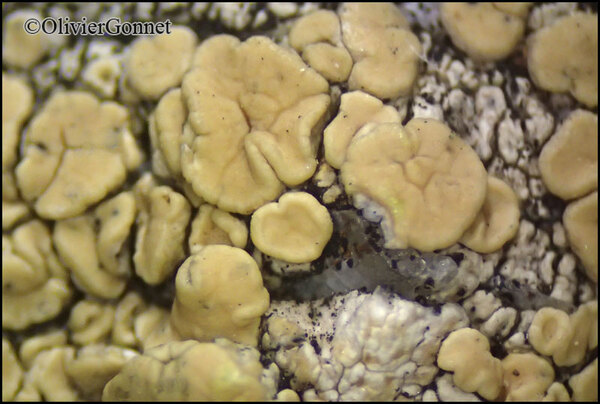
Courtesy Danièle et Olivier Gonnet - Source: https://www.afl-lichenologie.fr/Photos_AFL/Photos_AFL_L/Texte_L_4/Lecanora_alpigena.htm
France, Col du Petit Mont Cenis, 2200 m - Savoie
2/8/2013
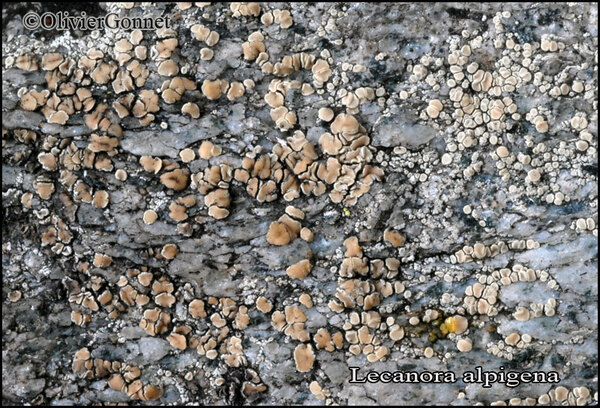
Courtesy Danièle et Olivier Gonnet - Source: https://www.afl-lichenologie.fr/Photos_AFL/Photos_AFL_L/Texte_L_4/Lecanora_alpigena.htm
France, Col du Petit Mont Cenis, 2200 m - Savoie
2/8/2013

Courtesy Danièle et Olivier Gonnet - Source: https://www.afl-lichenologie.fr/Photos_AFL/Photos_AFL_L/Texte_L_4/Lecanora_alpigena.htm
France, Col du Petit Mont Cenis, 2200 m - Savoie
2/8/2013
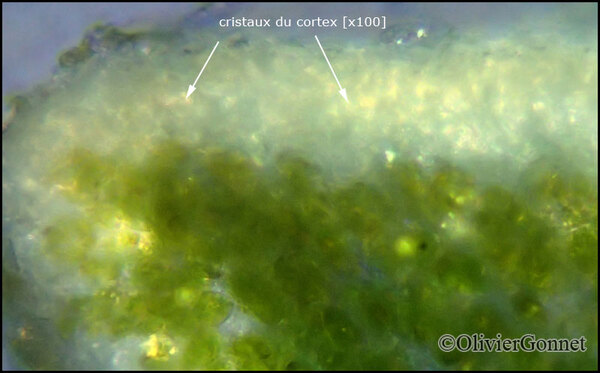
Courtesy Danièle et Olivier Gonnet - Source: https://www.afl-lichenologie.fr/Photos_AFL/Photos_AFL_L/Texte_L_4/Lecanora_alpigena.htm
France, Col du Petit Mont Cenis, 2200 m - Savoie
2/8/2013
Growth form: Crustose
Substrata: rocks
Photobiont: green algae other than Trentepohlia
Reproductive strategy: mainly sexual
Commonnes-rarity: (info)
Alpine belt: common
Subalpine belt: rather rare
Oromediterranean belt: absent
Montane belt: absent
Submediterranean belt: absent
Padanian area: absent
Humid submediterranean belt: absent
Humid mediterranean belt: absent
Dry mediterranean belt: absent

Predictive model
| Herbarium samples |

Courtesy Danièle et Olivier Gonnet - Source: https://www.afl-lichenologie.fr/Photos_AFL/Photos_AFL_L/Texte_L_4/Lecanora_alpigena.htm
France, Col du Petit Mont Cenis, 2200 m - Savoie
2/8/2013

Courtesy Danièle et Olivier Gonnet - Source: https://www.afl-lichenologie.fr/Photos_AFL/Photos_AFL_L/Texte_L_4/Lecanora_alpigena.htm
France, Col du Petit Mont Cenis, 2200 m - Savoie
2/8/2013

Courtesy Danièle et Olivier Gonnet - Source: https://www.afl-lichenologie.fr/Photos_AFL/Photos_AFL_L/Texte_L_4/Lecanora_alpigena.htm
France, Col du Petit Mont Cenis, 2200 m - Savoie
2/8/2013

 INDEX FUNGORUM
INDEX FUNGORUM
 GBIF
GBIF
 DOLICHENS
DOLICHENS
